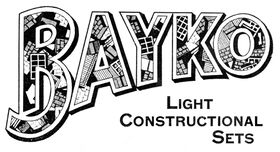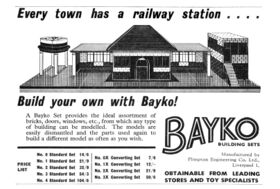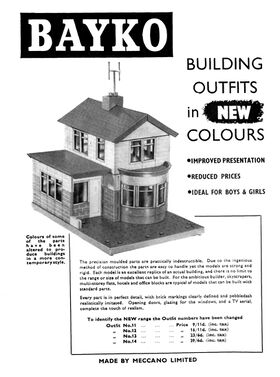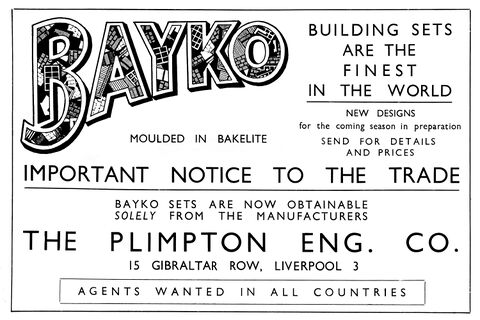Category:Bayko
| Toy Brands and Manufacturers |
|---|
Bayko |
| 1934 - 1960s |
1935: Build Better with Bayko [image info]
1954: "Oh Boy Bayko!" [image info]
1959: Bayko: "Every town has a railway station ... build your own with Bayko!" [image info]
1960 Meccano Ltd. Bayko advert, "New colours", "Made by Meccano Ltd" [image info]
Bayko joins the Meccano Ltd. fold [image info]
"Bayko builds best", Meccano Ltd. catalogue page from around ~1962/1963 [image info]
Bayko was a British "architectural" plastic construction system created by Plimpton Engineering in the 1930s, designed for making 1/43-scale ("gauge 0"-scale) model buildings.
The name is widely assumed to be a reference to "Bakelite", the early plastic material that its plastic parts were originally moulded from, but might also be related to the name of the larger Dutch wooden predecessor system that also involved panels and posts and a pierced baseboard, "Mobaco".
Bayko was widely respected due the the accuracy and finish of the resulting model buildings, and still has many adult fans who mourn its passing. There is still a thriving Bayko modelling community who exchange and sell spare parts, and who show Bayko buildings at model exhibitions.
Construction
The Bayko system managed to achieve a finer level of detail and architectural realism than many later systems (like the one used by Lego), because its plastic pieces didn't need their own pegging or connecting system, and could therefore be thinner and have finer detail. Bayko blocks were instead held together by being threaded onto vertical metal rods, which (for the lower rods) lined up with holes in the baseboard.
Charles Plimpton and Plimpton Engineering
Bayko was devised by Charles Bird Plimpton (1893-1948) during a long spell convalescing from tuberculosis ("TB"). Plimpton's period in the sanatorium left him with a lot of free time to decide what to do when he got out, and as a Liverpudlian, he can't have failed to notice that Meccano was very very successful. But how could one create a new construction toy that wasn't Meccano? The Dutch "Mobaco" system used a combination of baseplates with holes and wall and floor panels slotted between vertical wooden beams, and if this system could be refined and miniaturised so that it could be smaller and cheaper, using the new plastics, then this might be something that could be cheaper, more visually attractive, less cumbersome, and patentable.
Plimpton returned to normal life in 1933, and promptly got patent, set up Plimpton Engineering, struck up a friendly relationship with the Bakelite company, and released a range of five sets, 1-5, with upgrade sets also available (similar to the sales model previously used for Meccano sets.) The system was promoted as washable and hygienic, and therefore ideal for the sickroom (perhaps reflecting Charles Plimpton's own experiences).
Development
Originally available in brown and white with green window frames, Bayko added ornamental pieces in a separate addon pack, brought out a new Set 6 which included the new pieces, and then migrated everything to a new more brightly-coloured red, white and green "new series" colour scheme shortly before WW2.
Plimpton patented some designs for new Bayko pieces after the war, but died in 1948 before they could be put into production. The company continued independently for another ten years under the control of Charles' widow, Margaret, rationalising the number of sets while introducing the new pieces. With a good, stable, mature set of designs, an enthusiastic userbase and and good sales, the range didn't change much in the late 1950s, and Margaret decided to sell the company to Meccano Ltd., in around ~1959/60.
The brief "Meccano Ltd." years
Although the idea of Meccano Ltd owning Bayko may have seemed like a good one - Meccano Ltd was a manufacturing giant with its own magazine and distribution, and a metal-based product range that badly needed to gain knowledge of plastics manufacture – the transition effectively killed off Bayko.
Plimpton Engineering had already started trying to migrate some of the pieces from Bakelite to more modern (and cheaper) plastics, and while this process continued under Meccano Ltd, the ML engineers seem to have regarded Bayko as a useful testbed for developing their plastics knowledge, taking the product off the market for a year while they tinkered and reengineered it, after which the company's marketing department seem to have had rather less enthusiasm for actually selling the results, with Bayko advertised as a stand-alone product rather than as a useful (and now cheaper) system for making buildings that, for instance, worked well with Dinky Toys and other parts of the Meccano Ltd inventory.
At this point, Meccano Ltd. were having their own problems, and were taken over in 1964 by Lines Brothers,with Bayko being a casualty of the product line rationalisation. Lego was by now making serious inroads into the UK toy market, and those at Binns Road and/or Lines Brothers in charge of strategy seem to have decided that what they needed was a more modern system much more like Lego, launching their Lego-lookalike "Cliki" in late 1964.
If the company were making Cliki their new plastic construction system, it didn't make much sense to be supporting an older and incompatible system, so the arrival of Cliki pretty much meant that Bayko was now dead and buried (with advertising for Bayko already having stopped some time before the Cliki launch).
Ironically, Cliki then had to be withdrawn for infringing on the Lego company's intellectual property rights, and many Bayko enthusiasts never forgave Meccano Ltd for (as they saw it) having bought up Bayko just to "faff about" with the product and then kill it off.
Addresses
- Berwick's Toy Co. Ltd, South Hunter Street, Liverpool 1 (1935-)
- The Plimpton Engineering Company, 15 Gibraltar Row, Liverpool (1939-)
In the Museum
The museum displays include four built Bayko models and a variety of boxes.
External links
- Bring Back Bayko! (thedabbler.co.uk)
- Bayko history pages (plimpton.co.uk)
- Bayko (melright.com)
- Bayko, V&A (vam.ac.uk)
- Bayko (gracesguide.co.uk)
- Baykoman website (baykoman.com)
- Bayko collectors' Club (bayko.org.uk)
- Bayko Master Plans, new Bayko designs (hsomerville.co)
- Bayko Empire State Building (liverpoolmuseums.org.uk)
- Bayko (fanclastic.ru)
Patents
- Patent GB422645 (A) ― 1935-01-16 - An improved constructional building toy, Charles Bird Plimpton (espacenet.com)
- Patent GB613767 (A) ― 1948-12-02 – Improvements in constructional building toys, Charles Bird Plimpton (espacenet.com)
Bakelite
Pages in category ‘Bayko’
The following 7 pages are in this category, out of 7 total.
Media in category ‘Bayko’
The following 27 files are in this category, out of 27 total.
- A Milking Shed, in Bayko (MM 1963-10).jpg 1,103 × 1,393; 264 KB
- Airport Beacon design, Bayko New Parts, manual.jpg 1,200 × 1,050; 154 KB
- Bayko - The Up-to-Date Constructional Sets (MM 1935-11).jpg 1,715 × 2,200; 1,016 KB
- Bayko Building Outfits in New Colours (MM 1960-09).jpg 1,083 × 1,457; 192 KB
- Bayko buildings (MM 1954-03).jpg 1,099 × 1,600; 509 KB
- Bayko Builds Best (MCat ~1963).jpg 1,200 × 838; 210 KB
- Bayko Choice of Five (MCat ~1963).jpg 1,200 × 840; 211 KB
- Bayko logo (MM 1957-07).jpg 1,573 × 683; 100 KB
- Bayko logo 1935.jpg 2,000 × 1,087; 326 KB
- Bayko Railway Station (MM 1959-11).jpg 1,614 × 1,091; 293 KB
- Bayko range (MM 1954-06).jpg.jpg 1,600 × 1,225; 592 KB
- Bayko sets - He's a Bayko Boy (MM 1958-10).jpg 1,619 × 2,259; 630 KB
- Bayko Town Hall.jpg 768 × 1,024; 107 KB
- Bayko trade advert (GaT 1939-05).jpg 3,000 × 2,003; 1.29 MB
- Boys - Heres a new building Toy, Bayko (MM 1935-10).jpg 1,599 × 2,200; 750 KB
- Build All These with Bayko (MM 1954-08).jpg 1,088 × 1,600; 516 KB
- Build Better with Bayko (MM 1935-09).jpg 1,703 × 2,200; 720 KB
- Look what hes built with Bayko (MM 1957-07).jpg 1,130 × 1,600; 461 KB
- Meccano Ltd catalogue, early 1960s.jpg 1,200 × 836; 122 KB
- Methods of Using Bayko Parts, manual.jpg 583 × 442; 89 KB
- Model B15-1, Detached Residence with Pantile Roof, Bayko manual.jpg 1,600 × 1,153; 397 KB
- Mosque design, Bayko New Parts, manual.jpg 1,200 × 897; 168 KB
- Noahs Ark design, Bayko New Parts, manual.jpg 1,200 × 724; 168 KB
- Oh Boy Bayko, advert (MM 1954-01).jpg 1,121 × 1,600; 519 KB
- Oh Boy, Bayko, advert graphic (MM 1954-06).jpg 1,600 × 1,239; 249 KB
- Town Planning with Bayko (MM 1958-09).jpg 1,141 × 1,600; 291 KB





































